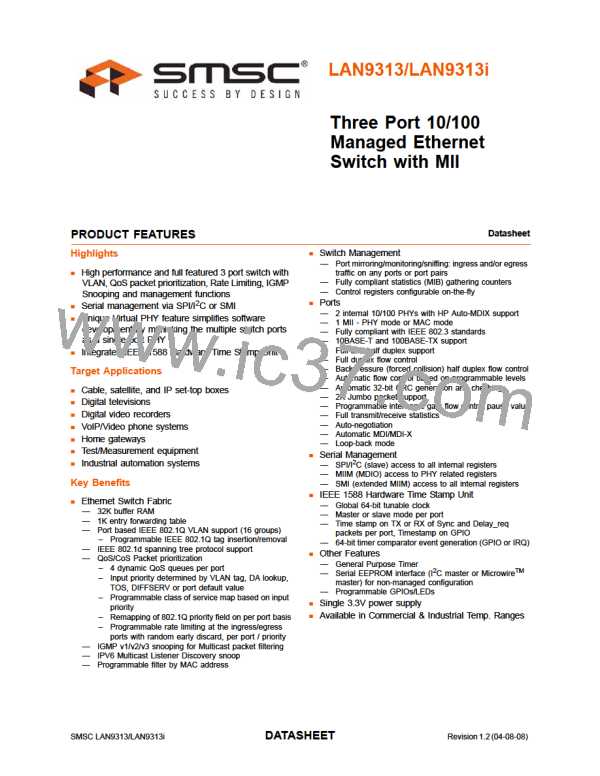Three Port 10/100 Managed Ethernet Switch with MII
Datasheet
10M PLL (analog)
10M TX Driver (analog)
Auto-negotiation is started by the occurrence of any of the following events:
Power-On Reset (POR)
Hardware reset (nRST)
PHY Software reset (via Reset Control Register (RESET_CTL), or bit 15 of the Port x PHY Basic
Control Register (PHY_BASIC_CONTROL_x))
PHY Power-down reset (Section 7.2.9, "PHY Power-Down Modes," on page 96)
PHY Link status down (bit 2 of the Port x PHY Basic Status Register (PHY_BASIC_STATUS_x) is
cleared)
Setting the Port x PHY Basic Control Register (PHY_BASIC_CONTROL_x), bit 9 high (auto-neg
restart)
Digital Reset (via bit 0 of the Reset Control Register (RESET_CTL))
Issuing an EEPROM Loader RELOAD command (Section 8.2.4, "EEPROM Loader," on page 113)
Note: Refer to Section 4.2, "Resets," on page 41 for information on these and other system resets.
On detection of one of these events, the PHY begins auto-negotiation by transmitting bursts of Fast
Link Pulses (FLP). These are bursts of link pulses from the 10M TX Driver. They are shaped as Normal
Link Pulses and can pass uncorrupted down CAT-3 or CAT-5 cable. A Fast Link Pulse Burst consists
of up to 33 pulses. The 17 odd-numbered pulses, which are always present, frame the FLP burst. The
16 even-numbered pulses, which may be present or absent, contain the data word being transmitted.
Presence of a data pulse represents a “1”, while absence represents a “0”.
The data transmitted by an FLP burst is known as a “Link Code Word.” These are defined fully in IEEE
802.3 clause 28. In summary, the PHY advertises 802.3 compliance in its selector field (the first 5 bits
of the Link Code Word). It advertises its technology ability according to the bits set in the Port x PHY
Auto-Negotiation Advertisement Register (PHY_AN_ADV_x).
There are 4 possible matches of the technology abilities. In the order of priority these are:
100M Full Duplex (highest priority)
100M Half Duplex
10M Full Duplex
10M Half Duplex (lowest priority)
If the full capabilities of the PHY are advertised (100M, full-duplex), and if the link partner is capable
of 10M and 100M, then auto-negotiation selects 100M as the highest performance mode. If the link
partner is capable of half and full-duplex modes, then auto-negotiation selects full-duplex as the highest
performance mode.
Once a speed and duplex match has been determined, the link code words are repeated with the
acknowledge bit set. Any difference in the main content of the link code words at this time will cause
auto-negotiation to re-start. Auto-negotiation will also re-start if all of the required FLP bursts are not
received.
Writing the Port x PHY Auto-Negotiation Advertisement Register (PHY_AN_ADV_x) bits [8:5] allows
software control of the capabilities advertised by the PHY. Writing the Port x PHY Auto-Negotiation
Advertisement Register (PHY_AN_ADV_x) does not automatically re-start auto-negotiation. The Port
x PHY Basic Control Register (PHY_BASIC_CONTROL_x), bit 9 must be set before the new abilities
will be advertised. Auto-negotiation can also be disabled via software by clearing bit 12 of the Port x
PHY Basic Control Register (PHY_BASIC_CONTROL_x).
SMSC LAN9313/LAN9313i
Revision 1.2 (04-08-08)
DATA9S3HEET

 SMSC [ SMSC CORPORATION ]
SMSC [ SMSC CORPORATION ]